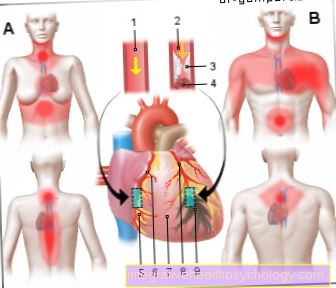Endurance Performance - How To Improve It
What is the endurance performance?
Endurance in sport is the body's resistance to fatigue under long-term stress and the organism's ability to regenerate after sport.
The endurance performance is accordingly the performance that is achieved over a period of time without a drop in performance due to fatigue.
The decline can occur both physically and cognitively.
The performance achieved is documented as well as the period and compared with figures from other athletes in order to classify and evaluate the performance.
The cardiovascular system is strongly challenged and promoted during endurance performance.

How can you improve endurance performance?
The basic requirement for increasing endurance is a healthy, balanced, low-fat diet, because the body gets its energy from food. In addition, an adequate supply of fluids is the basis for increased endurance.
In order to improve your endurance performance, it is important to formulate a clear end goal with intermediate goals in order to perceive your own endurance performance improvement.
The exercises for improvement should be individually tailored to the athlete and have a large number of variations.
Many different training methods are important as the body quickly gets used to a constant load.
Classic interval training is particularly useful for increasing endurance.
During a training session, you alternate between high stress phases and recovery.
It is also of great importance that you train regularly and stick to your plan exactly.
In addition, one should start slowly, gradually increasing the heart rate and only extend the training units over time.
The intensity and length of a training session should be increased in realistic, small steps.
At the beginning, the training units are short sequences that are repeated several times a week.
For more information on how you can specifically improve your endurance, read our article:How to improve your endurance!
Which deficiency can reduce endurance performance?
A deficiency in magnesium can reduce endurance performance because magnesium regulates the excitability of the cells and is responsible for the relaxation of the muscles, so that if you are deficient, you can suffer from leg cramps, for example.
Furthermore, an iron deficiency can also reduce endurance performance, because the body needs iron to produce red blood cells and to transport oxygen.
Other deficiencies that may lead to a reduction in performance are the calcium deficiency, calcium is required for building bones, the potassium deficiency, which causes muscle weakness, and some vitamin deficiencies.
This includes, for example, the vitamin B12 deficiency or vitamin E deficiency.
Which diet is useful for improving endurance performance?
Athletes need a high-carbohydrate diet such as potatoes or baked goods to improve endurance performance.
Carbohydrates serve as a source of energy in the form of glucose.
Depending on the composition of the glucose, it can take a while until the energy is available to the body.
When it comes to energy consumption, the body uses carbohydrate stores.
However, since these are only limited, it is important that you take in carbohydrates through your diet in order to be able to maintain the same endurance performance over long distances.
Whole-grain products such as whole-grain bread, whole-grain rice or whole-wheat pasta are valuable carbohydrates for athletes, as they only gradually give the body energy.
It is also important that athletes follow a low-fat diet.
A high-fat diet is stressful for the organism because it is difficult to digest and thus reduces performance in the event of long-term exposure.
However, the body needs fats, so athletes should also eat some, but pay attention to their quality and prefer vegetable fats to animal fats.
In addition, a sufficient supply of protein to the body is important not only in weight training, but also in endurance sports, since the body also uses protein as a source of power in extreme endurance sports.
Recommended sources of protein are the following foods, which are best eaten in combination with each other, lean meat, fish, eggs, low-fat dairy products, legumes, potatoes and grains.
You can find out what you should pay attention to in your diet as part of endurance sports at:
Endurance sports and nutrition - what to look out for
Iron deficiency
Iron is very important in the human body so that the body can produce red blood cells and these can ensure the supply of oxygen.
Female athletes in particular tend to have an iron deficiency, which is due, among other things, to their monthly menstrual period.
Iron is of great importance for the red blood cells because it helps to bind oxygen, in the mitochondria it is also needed for energy and it is important for muscle work.
To prevent deficiency, we recommend an iron-rich diet with the following foods that are high in iron:
- flesh
- liver
- Eggs
- whole grain products
- nuts
- legumes
- millet
- Spinach etc.
Do you suffer from iron deficiency and would you like to remedy it? Then read our article:
This is how you fix an iron deficiency
How can you determine endurance performance?
Compared to weight training, it seems to be a little more difficult to determine the performance achieved in endurance sports.
For recreational athletes in the endurance field, it is unusual to carry out endurance performance diagnostics, for example with a long-term EKG.
Nevertheless, it is possible that the athletes can roughly determine their endurance performance, if only in comparison to other athletes.
For example, if you go running, you can measure the length of the route and the time it takes to walk it.
These values can be collected so that an improvement or deterioration in endurance performance can also be recognized.
Such values can be compared well with the values of other athletes or even top athletes, so that a somewhat objective classification of one's own performance is possible. In addition, the pulse can be measured during sport and compared with pulse tables in order to be able to classify the values in their meaning.
The pulse values also provide information about performance.
Endurance performance diagnostics
Spiroergometry is used for endurance performance diagnostics.
The word is made up of spiro = breathing, ergo = work and metrie = measurement.
Breathing and oxygen uptake are measured while performing.
In addition, endurance performance is measured by an exercise ECG on a bicycle ergometer or by a lactate test.
However, these test methods are usually only chosen by professional athletes; pulse measurement is recommended for recreational athletes.
The pulse is not only measured during and after exercise, but also at rest in order to have comparative values.
In addition, your own physical sensation, such as changed breathing, can also be used for diagnostics.
Would you like to do endurance training at home and don't know exactly how?
Then read our relevant article on this: Endurance training at home
How much does smoking reduce endurance performance?
Smoking has a negative effect on the body, so that endurance performance is reduced, as the oxygen absorption capacity in the blood is reduced.
Inhaled smoke contains carbon monoxide, which binds to the red blood platelets and red blood pigment so that they can only carry less oxygen. The organs and muscles are supplied with less oxygen as a result, and smoking is also bad for the cardiovascular system, which is why it is also weakened.
In particular, the deteriorated oxygen uptake capacity leads to a decrease in performance in endurance athletes, but the exact reduction in endurance performance varies from athlete to athlete.
Learn more about how smoking affects the human body: Consequences of smoking





























